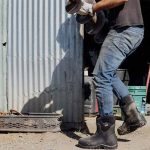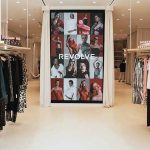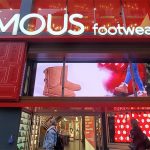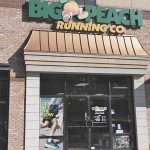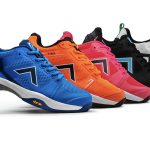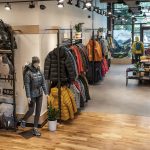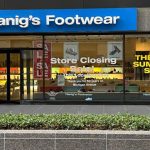At the Thomas Weisel Consumer Conference, executives began talking about ways to find growth for a change. While many cautioned that the market is not out of the woods yet and inventory and expense controls were in place, the execs appeared to agree that consumer spending had at least bottomed out this past back-to-school period and seemed more optimistic than they have been in awhile. Here's a recap of some of the major presentations:
Speaking at the Thomas Weisel consumer conference, Bob Shearer, VF Corp's SVP and CFO, said that its Wrangler and Lee brands are the most established in China, The North Face and Vans have the potential for the most growth in the region. Said Shearer, “We have these brands, these authentic brands that we feel that we can do that within China.”
“As those businesses get larger, there's some leverage of scale within the businesses, and the overall gross margin structure of those lifestyle businesses provide VF with a stronger overall margin potential as we look down the road,” said Shearer.
Asked about the recent hiring of David Conn from Iconix as head of VF licensing, Shearer said Conn will help VF explore a similar model of establishing some exclusive brands for larger retailers. He said the company continues “to do large businesses with those large retailers, but there's no question that their mindset is moving more and more toward exclusive brands. We wanted to make sure that we are giving ourselves the right opportunities in terms of aligning with their strategies.” He added that both an existing or an acquired brand could present an opportunity as an exclusive retail arrangement.
Regarding the outlook, Shearer said the fourth quarter is going to be “a lot better” than the third quarter primarily because of easy comparisons. Also, comparing comps in August versus July, he said, sales trends are “…better. It's more stable.”
But he said there remains a “very cautious view” in terms of open-to-buy across retail and added that the retailers appear to be committed to operating their businesses on lean inventory levels. “How long that will last is a little hard to say, but we are seeing a really cautious approach in terms of opening up that open to buy on inventories,” said Shearer.
Columbia Sportswear CFO Tom Cusick updated the company’s “three-pronged strategy,” which includes initiatives in its wholesales, distributor and retail businesses.
As of now, Cusick said Columbia has only sold through about 20% of its fall business at retail, and he added that the following couple of months will be crucial in determining the success of the back-end of 09’.
Cusick went on to cite Columbia’s 2010 footwear launch, which he said is a culmination of several initiatives set into motion a couple of years ago. The 2010 launch will focus on trail running but also incorporates water sports and boating categories. Cusick added that Columbia has set initiatives to increase its presence in the specialty channels, and the company has taken steps internally to motivate its sales teams to aggressively approach growth opportunities in the specialty channel. “ we’re planning to take share in (the) specialty channel basically across the board,” he added.
Cusick added that as the market returned to a state of normalcy and, assuming that the company can re-establish some presence in the specialty channel, they can return to operating margins that are in the low-to-mid teens. “[But] we absolutely need the top lines,” Cusick said, “we have to have that top line expansion in order to get operating income leverage.”
Cusick went on to cite weakness in Europe but maintained that the company expects to see improved results by 2011.
Cusick closed the conference by emphasizing growth opportunities through Columbia’s existing brand portfolio, but left open the possibility of future acquisitions, saying “[Acquisition] has not been our top priority. However, if the right opportunity is there to extend the brand we would definitely take a look at that.”
The company now expects fiscal third quarter 2009 comparable store sales to decline in the negative high-single digits to low-double digits versus its previous expectation for comparable store sales to decline in the low-to-mid teen range. Third quarter net income is now expected to range between 12 cents to 14 cents a share, up from its previously issued guidance of net income between 5 cents to 7 cents.
At the Thomas Weisel conference, the company said it has seen particular strength from the company’s younger, smaller brands. CFO Trevor Lang said footwear continues to be the strongest department while apparel has been the most challenging. Lang said the company did a “good job” in the BTS period, with comps relatively better than in the recent past. Rick Brooks, CEO, said it has been tough to find ways to express value because Zumiez “simply [doesn’t] have the room in terms of product margin to move [like] a vertically integrated player has.” Brooks added that the promotional retail environment has been difficult to compete with.
For Holiday 2009, Brooks said he hopes it to be less promotional than 08’, and he expects much of the initiatives for Zumiez to be based around margin recovery. He added that he thinks there is over-capacity in the action sports marketplace, but that it represents an opportunity for Zumiez because the company is “one of the few growth players out there.”
Regarding future store expansion, Brook said Zumiez would be extremely careful with rent structures, and noted that if the retailer could get restructured deals with landlords, it would be more aggressive in adding store locations.
Garmin Hopes Fitness, Marine Boost Sales
Rauckman estimates 10% sales growth for the company’s outdoor and fitness segments next year.
“I think the good news is, it is fashion,” said Fromm. “And I think that as we looked at building inventories and looking at where we saw greater “opportunities, we do believe and continue to believe that sort of the suburban athletic collection is going to be a key as we continue forward this year.”
Fromm also said there’s more consumer interest in boots, and Famous is starting to get “some real traction” in the wellness category, driven by MBT that it carries at its Naturalizer chain but now by Skechers Shape Ups, Reebok's Tone, as well as its own Dr. Scholl's model.
Overall, however, Fromm expects retailers will continue to “very thoughtful about when we place orders and how we flow goods so that we continue to build protection, if you will, as you go out there. So I think it is not nearly as cautious as it was a year ago, but I think it is still very planned. It is not gambling.”
Duerden said he was unhappy with the fact that Crocs’ products didn’t tell a story sufficiently, and he pledge to place more focus on merchandising and product promotion. He also stressed the importance of tapping opportunities within the work and medical segment. To conclude the conference, CFO Russ Hammer called pre-booking orders in the US and Asia “very strong.”
Speaking at the Thomas Weisel consumer conference, Steve Miller, Big 5 Sporting Goods' president and CEO, said consumer spending appears to be picking up.
“It certainly improved for us over how they were for I guess the six quarters preceding Q2 of this year. Most of our gains are traffic driven, so we are definitely seeing a return of traffic in our stores, absolutely.”
Asked how Big 5 is benefiting from the downturn, Miller described the retailers access to open-to-buys as “healthy” and “favorable for some period of time, and it really remains that way today. We are seeing great opportunities really across all of our major product categories.” He said that due to the exit of Joes Sports, Mervyns, Gottschalks and Shoe Pavilion, among others, Big 5 is “benefiting from a more rational competitive environment.”
Asked about the entry of Dick's Sporting Goods in its market, Miller said the company has long faced new competitors in its market but he also believes Dick's SG's and other big box chains have a different business model. Said Miller, “We have a model that allows us to really out-store the big boxes in the metropolitan areas as well, as a model that we can take down to much smaller marketplaces as well.”
He did note that although the Coleman, a $900 million brand, is kind of battening down the hatches,” it will increase its sales by $50 million to $70 million in one unmentioned retailer.
Overall, Lillie saw that although Jarden “really haven't seen reorders,” he’s optimistic that the trend will start improving. “As we look out, we are starting to see that reorder activity gradually pump up a little bit.”
Regarding acquisitions, Lillie said that although the company has been tagged as “serial acquirers,” it hasn't acquired a company since buying K2 Inc. two years ago. But he did say Jarden was interested in a deal to spark its international growth.
“It would be nice to buy a North American company with European assets so you didn't have to buy euros if you will. But we are looking at things in Europe, we are looking at things in Australia, we are looking at things in Latin America,” said Lillie.
Iconix Brand Group, Inc. revised its full year 2009 revenue guidance to a range of approximately $215 million to $220 million from prior guidance of a range of $223 million to $230 million, which now represents an increase of approximately 5% over last year's adjusted revenue.
Adjusted revenues and non-GAAP net income amounts for 2008 referred to exclude $8.4 million and $5.4 million, respectively, related to gains from the formation of Iconix Latin America and Iconix China joint ventures recorded in the second half of 2008.
The company also estimates third quarter 2009 revenue to be approximately $53 million to $56 million, an increase of approximately 4% over the last year's Q3 adjusted revenue of $52.5 million. The company expects to see an increase of approximately 20% in its third quarter 2009 non-GAAP net income to approximately $19 million to $21 million from adjusted non-GAAP net income of $16.6 million in the prior year period. The company expects third quarter 2009 non-GAAP diluted EPS to be approximately 26 cents to 28 cents, which includes approximately 5 cents of dilution related to the company's June equity offering and an approximate 4 cents negative impact related to the transition of the Rocawear women's license to a new licensee.
Adjusted revenues and non-GAAP net income for the third quarter of 2008 exclude $2.6 million and $1.7 million, respectively, related to the gain from the formation of Iconix China joint venture recorded in the third quarter of 2008.
Non-GAAP net income amounts for 2008 and 2009 also give effect to the company's adoption of APB 14-1.

